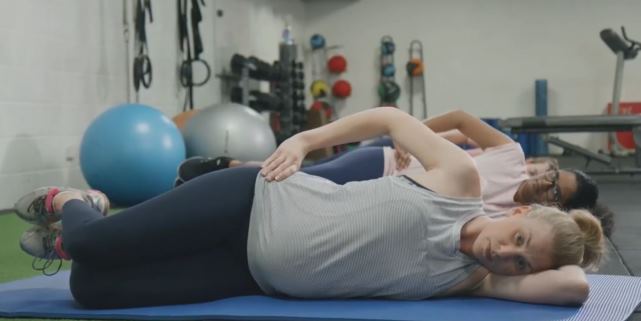Exercising your abdominal muscles (including your pelvic floor)
As your pregnancy progresses, the abdominal (stomach) muscles stretch to accommodate your growing baby.
The deep core abdominal muscles run horizontally around your abdomen, to support your back and also your baby as they grow.
Exercising them helps keep them strong, prevents back pain and supports your growing uterus and baby. Exercising these muscles will make it easier to regain strength and tone after your baby is born.
Acivate those pelvic floor muscles
What is the pelvic floor?
The pelvic floor consists of layers of muscles that stretch like a supportive hammock from your tailbone to the pubic bone at the front of your pelvis. Pelvic floor muscles help to:
-
support your bladder, bowel and womb including your growing baby
-
support your lower back, hips and pelvis
-
maintain control of your bladder and bowel
-
enhance sensation and satisfaction during sexual intercourse
Why exercise your pelvic floor?
During pregnancy, your pelvic floor muscles weaken as they support the increasing weight of your growing baby. Weak pelvic floor muscles can cause incontinence, particularly when you urgently need to go tot he toilet, when you sneeze or cough.
How to strengthen your pelvic floor
-
Move into a comfortable position (lying on your side or sitting)
-
Lift and squeeze the muscles around your back passage (anus) and vagina, lifting and drawing these muscles forwards and upwards (i.e. magine you are trying to stop the passing of wind and urine)
-
Continue to breathe normally and ensure your legs and buttocks are relaxed
-
At the end of each squeeze, you should have a distinct feeling of the muscles “letting go” and releasing.
View more safe exercises for pregnancy

Strong abdominal muscles can help support your baby and reduce strain on your back. Imagine you are giving your baby a gentle hug with your abdominal muscles.
How to exercise the deep abdominal muscles
To find these deep muscles, start by standing tall or lying down on your side. Some people find it easier to feel these muscles work by getting down on your hands and knees.
-
Let your abdominal muscles relax while keeping your back straight
-
Gently draw in the abdominal muscles below your belly button toward your spine and up slightly, activating your pelvic floor may help
-
Remember to keep breathing through this exercise and ensure that your upper tummy remains relaxed
-
Hold in as long as you feel comfortable and then relax
-
Repeat this 10 times, twice a day working up to holding up to 10 seconds.
Progress these exercises by activating your pelvic floor and deep abdominal muscles whilst adding an arm or leg movement or as you change position from sitting to standing.
Weak pelvic floor muscles can cause urinary incontinence, particularly when you cough or sneeze. Remember to squeeze and hold your pelvic floor muscles before coughing, sneezing or lifting to provide support and prevent leakage of urine.
How much and how often?
-
At the start you may only be able to squeeze and lift your muscles for three to four seconds at a time
-
As this becomes easier, build this number up and aim to hold for 10 seconds
-
Rest for 10 seconds
-
Repeat this up to 10 times
-
Aim for three sets of 10 squeezes each day during your pregnancy
-
Make it part of your daily routine (e.g. after going to the toilet (not during), before meals, before bed, on the way to work). Set a reminder in your phone or download the Pregnancy Pelvic Floor Plan app
-
You can progress by performing these exercises in the standing position.
Caring for your back
During pregnancy the hormones, weight gain and postural changes affect the strain on your ligaments by softening them and can make you more likely to experience back or pelvic joint pain. It is important to protect your joints during pregnancy with good posture and safe lifting techniques.
What is good posture?
When STANDING, make sure you:
-
Distribute your weight evenly between both feet
-
Stand tall
-
Gently pull your shoulder blades back, down and together
-
Gently tuck your chin in.
When SITTING, make sure you:
-
Always sit in a supportive chair; avoid a saggy couch or sofa
-
Position your bottom well back in the chair
-
Support your lower back by placing a rolled up towel or lumbar roll in the small of your back.
-
Have both feet supported on the floor
-
Avoid crossing your legs
-
Gently pull your shoulder blades back, down and together.
Protecting your back and pelvis with good posture and safe lifting is important in pregnancy. It is difficult to avoid all lifting in pregnancy, so avoid all heavy lifting and take care lifting children.
How to lift safely
-
Activate your pelvic floor and deep abdominal muscles
-
Bend your knees and push through your legs
-
Keep your back straight to avoid strain
-
Keep the load close to you
-
Break up lifting tasks (it is better to carry several small loads of washing and shopping than one big load).